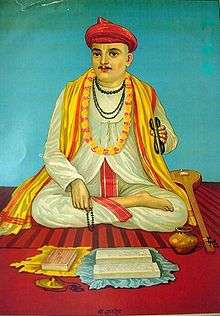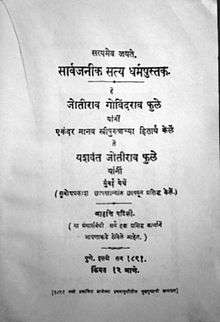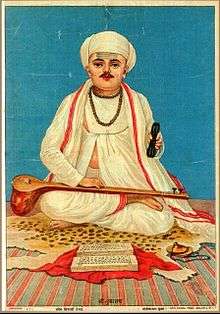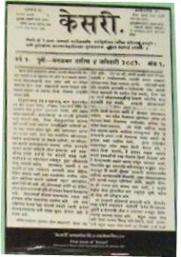Marathi literature
| Indian literature |
|---|
Marathi literature is the body of literature of Marathi, an Indo-Aryan language spoken mainly in the Indian state of Maharashtra and written in the Devanagari script.
History
Yadav period is significant in the history of maharashtra. Marathi literature is the oldest of the Indo-Aryan literatures, dating to about 1000 CE. In the 13th century, two Brahmanical sects arose, the Mahanubhava and the Varakari Panth, that both shaped Marathi literature significantly. The latter sect was perhaps the more productive, for it became associated with bhakti movements, particularly with the popular cult of Vitthoba at Pandharpur. It was out of this tradition that the great names of early Marathi literature came: Jnaneshvara, in the 13th century; Namdev, his younger contemporary, some of whose devotional songs are included in the holy book of the Sikhs, the Adi Granth; and the 16th-century writer Eknath, whose best-known work is a Marathi version of the 11th book of the Bhagavata-purana. Among the bhakti poets of Maharashtra, the most famous is Tukaram, who wrote in the 16th century. A unique contribution of Marathi is the tradition of povadas, heroic stories popular among a martial people. This tradition was particularly vital during the 17th century, when Shivaji, the great Maratha king, led his armies against the might of the Mughal emperor Aurangzeb.
Yadava period

Epigraphic evidence suggests that Marathi was a standard written language by the 12th century. However, the earliest records of actual literature in Marathi appear only in the late 13th century.[1] The early Marathi literature emerged during the Seuna (Yadava) rule, because of which some scholars have theorized that it was produced with support from the Yadava rulers.[2] The Yadavas did regard Marathi as a significant language for connecting with the general public,[3] and Marathi replaced Kannada and Sanskrit as the dominant language of the inscriptions during the last half century of the Yadava rule.[4] However, there is no evidence that the Yadava royal court directly supported the production of Marathi literature with state funds.[5]
The early Marathi literature was mostly religious and philosophical in nature,[6] and was composed by the saint-poets belonging to Mahanubhava and Warkari sects. During the reign of the last three Yadava kings, a great deal of literature in verse and prose, on astrology, medicine, Puranas, Vedanta, kings and courtiers were created. Nalopakhyan, Rukmini Swayamvar and Shripati's Jyotishratnamala (1039) are a few examples.
Bhaskarbhatta Borikar of the Mahanubhava sect is the first known poet to have composed hymns in Marathi.[7]
Dnyaneshwar (1275–1296) was the first Marathi literary figure who had wide readership and profound influence.[6] His major works are Amrutanubhav and Bhavarth Deepika (popularly known as Dnyaneshwari). Bhavarth Deepika is a 9000-couplets long commentary on the Bhagavad Gita.
Namdev, the Bhakti saint and contemporary of Dnyaneshwar is the other significant literary figure from this era. Namdev composed religious songs in Marathi as well as Hindi; some of his Hindi compositions are included in the Sikh holy book, the Guru Granth Sahib.
Another early Marathi writer was Mukundaraja, who wrote Vivekasindhu and Paramamrita. Both the works deal with the Advaita philosophy.[8] Some earlier scholars dated him to the 12th century, and considered Vivekasindhu as the first literary book in Marathi, dating it to 1188. However, most linguistic historians now date Mukundaraja to 14th century or later: the Vivekasindhu was likely written after Lilacharita and Dnyaneshwari.[9]
Sultanate period
There was relatively little activity in Marathi in the early days of the Bahmani Sultanate (1347–1527) and the Bijapur Sultanate (1527–1686). The Warkari saint-poet Eknath (1533–1599), the main successor of Dnyaneshwar, was a major Marathi literary figure during this period. He made available an authentic, edited version of Dnyaneshwari, which had been forgotten after the Islamic invasion of Deccan.[6] He also wrote several abhangs (devotional poems), narratives and minor works that dealt with the Bhagavata Purana He wrote Eknathi Bhagwat, Bhavarth Ramayan, Rukmini Swayamwar Hastamalak, and Bharud. Dasopant was another minor but notable poet from this era.[6] Mukteshwar (1574-1645), the grandson of Eknath, too, wrote several works in Marathi including a translation of the epic Mahabharata.
Krista Purana, written by the Goa-based Christian missionary Thomas Stephens, was first published in 1616. It is written in a mix of Marathi and Konkani languages, and the first copy was printed in the Roman script, and tells the story of Jesus Christ.[10]
Maratha period
The Marathas, the Marathi-speaking natives, formed their own kingdom in the 17th century. The development of the Marathi literature accelerated during this period. Although their leader, Shivaji, was formally crowned as the king in 1674, he had been the de facto ruler of a large area in Western Maharashtra for some time. Tukaram and Samarth Ramdas, who were contemporaries of Shivaji, were the well-known poets of the early Maratha period.[11] Tukaram (1608–1650) was the most prominent Marathi Varkari spiritual poet identified with the Bhakti movement, and had a great influence on the later Maratha society. His contemporary, Samarth Ramdas composed Dasbodh and Manache Shlok in Marathi.
In the 18th century, several well-known works like Yatharthadeepika (by Vaman Pandit), Naladamayanti Swayamvara (by Raghunath Pandit), Pandava Pratap, Harivijay, Ramvijay (by Shridhar Pandit) and Mahabharata (translation by Moropant) were produced. The historical section of the old Marathi literature contained the Bakhars and the Katavas. Krishna Dayarnava and Sridhar were other leading poets during the Peshwa rule.[6] Mahipati, the author who wrote the biographies of the Bhakti Saints also belonged to this era.
British Period

The British colonial period (also known as the Modern Period) saw standardisation of Marathi grammar through the efforts of the Christian missionary William Carey. Carey's dictionary had fewer entries and Marathi words were in Devanagari script instead of the Modi script prevalent at that time.[12] Carey also translated the new and old testament of the bible into Marathi in 1811 and 1820 respectively[13] The most comprehensive Marathi-English dictionaries was compiled by Captain James Thomas Molesworth and Major Thomas Candy in 1831. The book is still in print nearly two centuries after its publication.,[6][14] The colonial authorities also worked on standardizing Marathi under the leadership of Molesworth . They used Brahmins of Pune for this task and adopted the Sanskrit dominated dialect spoken by this caste in the city as the standard dialect for Marathi.[15] The Christian missionaries introduced the Western forms to the Marathi literature. [note 1]
Marathi at this time was efficiently aided by Marathi Drama. Here, there also was a different genre called 'Sangit Natya' or Musicals. The first play was V.A. Bhave's Sita Swayamvar in 1843 Later Kirloskar (1843–85) and G.B. Deval (1854-19l6) brought a romantic aroma and social content. But Krishnaji Prabhakar Khadilkar (1872-1948) with his banned play Kichaka-Vadh (1910) set the trend of political playwriting. These were followed by stalwarts like Ram Ganesh Gadkari and Prahlad Keshav Atre.
The modern poets like Keshavsuta, Balakavi, Govindagraj, and the poets of Ravi Kiran Mandal (such as Madhav Julian) wrote poetry which was influenced by the Romantic and Victorian English poetry. It was largely sentimental and lyrical. Prahlad Keshav Atre, the renowned satirist and a politician wrote a parody of this sort of poetry in his collection Jhenduchi Phule.
Sane Guruji (1899–1950) contributed to the children's literature in Marathi. His major works are Shyamchi Aai, Astik and Gode Shevata. He translated and simplified many Western Classics and published them in a book of stories titled Gode Goshti (Sweet Stories).
Beginning of journalism
On January 6, 1832, Balshastri Jambhekar of the Elphinstone College began Darpan, the first Marathi-English fortnightly magazine.[16]
On 24 October 1841, Govind Vithal Kunte began Prabhakar. Kunte was the first professional Marathi journalist. Prabhakar eulogised Indian art and culture. Jnyanodaya was begun in 1842 by Christian missionaries in Western India. Jnyan Prakash was started on 12 February 1849 in Pune. It was edited by Krishnaraj Trimbak Ranade. It was a weekly till 1904, when it became a daily. It ceased publication in 1951. It was a prestigious journal and supported education and social reform. Hari Narayan Apte, a famous Marathi novelist served as its editor. Some of its contributors included Mahadev Govind Ranade and Gopal Krishna Gokhale.
In the early years of Marathi journalism, most periodicals were concerned with spreading education and knowledge. These include Jaganmitra (from Ratnagiri), Shubh Suchak (from Satara), Vartaman Dipika, Vartaman Sangrah. In 1862, Induprakash was begun in Bombay (now Mumbai). It was a bilingual journal, edited by M.G. Ranade. It criticised orthodoxy and was the mouthpiece of many social reforms. In 1877, Jyotiba Phule and Krishnarao Bhaskar began Deenbandhu, as part of the Dalit upliftment movement. Deenabandhu was the organ of the Satyashodhak Samaj founded by Phule.
On 4 January 1881, Bal Gangadhar Tilak began Kesari, along with Gopal Ganesh Agarkar. In 1887, Agarkar left to start sujeet Sudharak (bilingual) along with Gopal Krishna Gokhale. After Agarkar's death in 1895, it ceased publication. In 1889, K. Navalkar started the weekly Vartahar to highlight atrocities committed by Europeans. In 1890, Hari Narayan Apte began Karmanuk as a family entertainment paper. It contained articles on science. Also in 1890, Anandrao Ramachandra Dharandhar started Bhoot published every new and full moon day. It was the first Marathi paper to carry cartoons on political and social matters. It was very popular but ceased publication in 1904.
Present times (1947-
Vishnu Sakharam Khandekar (1889–1976)'s Yayati won him the Jnanpith Award for 1975. He also wrote many other novels, short stories, essays etc. His major works are Don Dhruv (Two Poles), Ulka (Meteorite), Krounchavadh, Jalalela Mohar, Amrutvel.
Marathi drama flourished in the 1960s and 1970s, with literary figures like Vasant Kanetkar, Kusumagraj and Vijay Tendulkar.
The major paradigm shift in Marathi literature sensibilities began in the forties with the modernist poetry of B.S. Mardhekar. In the mid fifties, the little magazine movement gained momentum. It published writings which were non-conformist, radical and experimental. Dalit literary movement also gained strength due to the little magazine movement. This radical movement was influenced by the philosophy of Babasaheb Ambedkar and challenged the literary establishment which was largely middle class, urban, and upper caste people. The little magazine movement threw up many noted writers. Bhalchandra Nemade is a well-known novelist, critic and poet. Sharad Rane is a well-known child literary figure. The notable poets include Arun Kolatkar, Dilip Chitre, Namdeo Dhasal, Vasant Abaji Dahake and Manohar Oak. Bhau Padhye, Vilas Sarang, Shyam Manohar, Suhas Shirvalkar and Visharm Bedekar are well known fiction writers.[17]
Another major shift sensibility began in the nineties with the poems and criticism of Shridhar Tilve and the poetry of poets associated with Saushthav, Abhidhanantar and Shabadavedh. In the post nineties, this 'new little magazine movement' gained momentum and poets like Shridhar Tilve who stood against postmodernism and nativism and poets like Manya Joshi, Hemant Divate, Sachin Ketkar, Mangesh Narayanrao Kale, Saleel Wagh, Mohan Borse, Nitin Kulkarni, Nitin Arun Kulkarni, Varjesh Solanki, Sandeep Deshpande, Vasant Gurjar who touched the new areas of post-modern life. The poetry collections brought out by Abhidhanantar Prakashan, Time and Space, Popular Prakashan, Navta Prakashan and the regular issues of the magazine Abhidhanantar and IRREGULAR issues of Saushthav, Shabdvedh are taking Marathi poetry to the global standards. Another leading wave in contemporary Marathi poetry is the poetry of new dalit wave poets like Arun Kale, Bhujang Meshram and new deshi wave poets like Pravin Bandekar, Shrikant Deshmukh and Veerdhaval Parab.
Marathi science fiction has a rich heritage and boasts of modern complex stories. The known Marathi science fiction authors are Dr. Jayant Narlikar, Dr Bal Phondke, Subodh Javadekar, Niranjan Ghate, and Laxman Londhe. edh Over the last century or so, a number of producing encyclopedias have been produced in marathi. These include . Shreedhar Venkatesh Ketkar's 'Dnyaankosh', Siddheshwarshastri Chitrao's 'Charitra Kosh', Mahadevshastri Joshi's 'Bharatiy Sanskrutikosh', and Laxmanshastri Joshi's 'Dharmakosh' and 'Marathi Vishwakosh'. The Marathi theatre was complimented by Marathi films which did not enjoy a continuous success. Starting with V. Shantaram and before him the pioneer Dadasaheb Phalke (during the British period), Marathi cinema went on to influence contemporary Hindi cinema. Marathi language as spoken by people here was throughout influenced by drama and cinema along with contemporary literature.
Dalit Literature
It was in 1958, that the term "Dalit literature" was used for the first time, when the first conference of Maharashtra Dalit Sahitya Sangha (Maharashtra Dalit Literature Society) was held at Mumbai, a movement inspired by 19th century social reformer, Jyotiba Phule and eminent dalit leader, Dr. Bhimrao Ambedkar.[18]
Baburao Bagul (1930–2008) was a pioneer of Dalit writings in Marathi.[19] His first collection of stories, Jevha Mi Jat Chorali (जेव्हा मी जात चोरली) (When I Concealed My Caste), published in 1963, created a stir in Marathi literature with its passionate depiction of a cruel society and thus brought in new momentum to Dalit literature in Marathi.[20][21] Gradually with other writers like, Namdeo Dhasal (who founded Dalit Panther), these Dalit writings paved way for the strengthening of Dalit movement.[22] Notable Dalit authors writing in Marathi include Arun Kamble, Shantabai Kamble, Raja Dhale, Namdev Dhasal, Daya Pawar, Annabhau Sathe, Laxman Mane, Laxman Gaikwad, Sharankumar Limbale, Bhau Panchbhai, Kishor Shantabai Kale, Narendra jadhav, Namdeo Vatkar, Ashok Vatkar, Baliram G. Kamble and Urmila Pawar.
Awards
Four Marathi writers have been honored with the Jnanpith Award:[23]
Every year, Sahitya Akademi gives the Sahitya Akademi Award to Marathi writers for their outstanding contribution to Marathi literature.[24] See the List of Sahitya Akademi Award winners for Marathi.
See also
Notes
- ↑ According to Hartmut Scharte, Professor Emeritus of Sanskrit, University of California, Los Angeles, USA vide his book "A History of Indian Literature - Grammatical Literature", the author of the first Marathi Grammar was Venkata Madhava, who was a lecturer in Fort St. George College, Madras (now Chennai). Venkata Madhava's three works on Marathi (as was spoken by the then large Maratha colony of Tanjore) exist only in the autographs of the author or his assistant Bhima Pandita. His Marathi Grammar book "महाराष्ट्र प्रयोग चंद्रिका" was written cir. 1827. It has 227 sutras in Samskrt and is accompanied by a Samskrt commentary, a Marathi commentary and Marathi illustrations. The Samskrt section is written in Devnagari script and the Marathi in Modi script. The grammar which generally follows the Siddhanta Kaumudi in its design, was probably meant to introduce Marathi to the neighbouring Tamil speakers.
References
- ↑ Christian Lee Novetzke 2016, p. 54.
- ↑ Christian Lee Novetzke 2016, p. 74,86.
- ↑ Christian Lee Novetzke 2016, p. x.
- ↑ Christian Lee Novetzke 2016, p. 53.
- ↑ Christian Lee Novetzke 2016, p. 74.
- 1 2 3 4 5 6 Kusumavati Deshpande; Sadashiva Shivaram Bhave (1988). "Marathi". In Nagendra. Indian Literature. Prabhat Prakashan. pp. 202–. Retrieved 8 April 2012.
- ↑ Amaresh Datta (2006). The Encyclopaedia Of Indian Literature (Volume Two) (Devraj To Jyoti). Sahitya Akademi. p. 1624. ISBN 978-81-260-1194-0. Retrieved 8 April 2012.
- ↑ Shrikant Prasoon (2009). Indian saints and sages. Pustak Mahal. pp. 139–. ISBN 978-81-223-1062-7. Retrieved 8 April 2012.
- ↑ Christian Lee Novetzke 2016, p. 88.
- ↑ Winand M. Callewaert; Rupert Snell (1994). According to Tradition: Hagiographical Writing in India. Otto Harrassowitz Verlag. pp. 164–. ISBN 978-3-447-03524-8. Retrieved 8 April 2012.
- ↑ Neeti M. Sadarangani (2004). Bhakti Poetry in Medieval India: Its Inception, Cultural Encounter and Impact. Sarup & Sons. pp. 45–. ISBN 978-81-7625-436-6. Retrieved 8 April 2012.
- ↑ Chavan, Dilip. (2013). “Language Politics: Translation of Coercion into Consent”, Language Politics under Colonialism: Caste, Class and Language Pedagogy in Western India, Cambridge Scholars, 71-135
- ↑ Smith, George (2011). The life of William Carey : shoe-maker and missionary. New York: Cambridge University Press. p. 239. ISBN 9781108029186. Retrieved 19 December 2016.
- ↑ James, Molesworth, Thomas Candy, Narayan G Kalelkar (1857). Molesworth's, Marathi-English dictionary (2nd ed.). Pune: J.C. Furla, Shubhada Saraswat Prakashan. ISBN 81-86411-57-7.
- ↑ Chavan, Dilip (2013). Language politics under colonialism : caste, class and language pedagogy in western India (first ed.). Newcastle upon Tyne: Cambridge Scholars. pp. 136–184. ISBN 978-1443842501. Retrieved 13 December 2016.
- ↑ John V. Vilanilam (5 November 2005). Mass Communication In India: A Sociological Perspective. Sage Publications. pp. 57–. ISBN 978-0-7619-3372-4. Retrieved 8 April 2012.
- ↑ Nalini Natarajan; Emmanuel Sampath Nelson; Shripad D. Joshi (1996). "8 Twentieth Century Marathi Literature". Handbook of Twentieth-century Literatures of India. Greenwood Publishing Group. pp. 207–233. ISBN 978-0-313-28778-7.
- ↑ Natarajan, Nalini; Emmanuel Sampath Nelson (1996). "Chap 13: Dalit Literature in Marathi by Veena Deo". Handbook of twentieth-century literatures of India. Greenwood Publishing Group. p. 363. ISBN 0-313-28778-3.
- ↑ Issues of Language and Representation:Babu Rao Bagul Handbook of twentieth-century literatures of India, Editors: Nalini Natarajan, Emmanuel Sampath Nelson. Greenwood Publishing Group, 1996. ISBN 0-313-28778-3. Page 368.
- ↑ Mother 1970 Indian short stories, 1900–2000, by E.V. Ramakrishnan, I. V. Ramakrishnana. Sahitya Akademi. Page 217, Page 409 (Biography).
- ↑ Jevha Mi Jat Chorali Hoti (1963) Encyclopaedia of Indian literature vol. 2. Editors Amaresh Datta. Sahitya Akademi, 1988. ISBN 81-260-1194-7. Page 1823.
- ↑ "Of art, identity, and politics". The Hindu. Jan 23, 2003.
- ↑ "Jnanpith Laureates Official listings". Retrieved 2012-04-08.
- ↑ "sahitya-akademi.org". sahitya-akademi.org. Archived from the original on 2006-12-30.
Bibliography
- Christian Lee Novetzke (2016). The Quotidian Revolution: Vernacularization, Religion, and the Premodern Public Sphere in India. Columbia University Press. ISBN 978-0-231-54241-8.
- M. K. Nadkarni (1921). A short history of Marathi literature. Luhana Mitra Steam Printing Press, Baroda. (PDF form)
External links
| Wikimedia Commons has media related to Marathi language literature. |
- Marathi Literature in the Twenty-first Century: An Overview
- A Brief Introduction to New Marathi Poetry on Poetry International Web
- Globalization and New Marathi Poetry
- Devotional Aartis of Maharashtra
- Marathi Poetry in the Early Twentieth Century
- Marathi Literature of Maharashtra
- Contemporary Marathi Writers
- Sachin Ketkar's article on Brief History of Marathi poetry in past one hundred years

